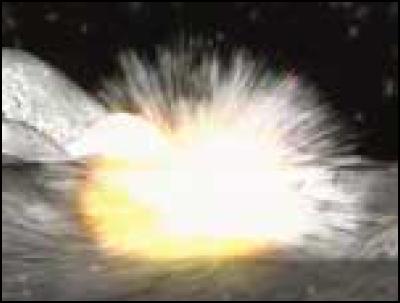Lunar Prospector Crash Fails To Make A Splash
NASA NEWS RELEASE
Lunar Prospector slams into a crater at the moon's south pole in this computer simulation image.

Image courtesy of
Nasa
The controlled crash of NASA's Lunar Prospector spacecraft into a crater near the south pole of the Moon on July 31 produced no observable signature of water, according to scientists digging through data from Earth-based observatories and spacecraft such as the Hubble Space Telescope.
This lack of physical evidence leaves open the question of whether ancient cometary impacts delivered ice that remains buried in permanently shadowed regions of the Moon, as suggested by the large amounts of hydrogen measured indirectly from lunar orbit by Lunar Prospector during its main mapping mission.
Research group leaders from the University of Texas at Austin announced their results today at the annual meeting of the American Astronomical Society's Division for Planetary Sciences meeting in Padua, Italy.
In a low-budget attempt to wring one last bit of scientific productivity from the low-cost Lunar Prospector mission, NASA worked with engineers and astronomers at the University of Texas to precisely crash the barrel-shaped spacecraft into a specific shadowed crater. NASA accepted the team's proposal based on successful scientific peer review of the idea and the pending end of the spacecraft's useful life, although the chances of positive detection of water were judged to be less than 10 percent.
Worldwide observations of the crash were focused primarily on using sensitive spectrometers tuned to look for the ultraviolet emission lines expected from the hydroxyl (OH) molecules that should be a by-product of any icy rock and dust kicked up by the impact of the 354- pound spacecraft.
"There are several possible
explanations why we did not detect any water signature, and
none of them can really be discounted at this time," said
Dr. Ed Barker, assistant director of the university's
McDonald Observatory at UT Austin, who coordinated the
observing campaign. These explanations include:
* the
spacecraft might have missed the target area;
* the
spacecraft might have hit a rock or dry soil at the target
site;
* water molecules may have been firmly bound in
rocks as hydrated mineral as opposed to existing as free ice
crystals, and the crash lacked enough energy to separate
water from hydrated minerals;
* no water exists in the
crater and the hydrogen detected by the Lunar Prospector
spacecraft earlier is simply pure hydrogen;
* studies of
the impact's physical outcome were inadequate;
* the
parameters used to model the plume that resulted from the
impact were inappropriate;
* the telescopes used to
observe the crash, which have a very small field of view,
may not have been pointed correctly;
* water and other
materials may not have risen above the crater wall or
otherwise were directed away from the telescopes' view.
Although the crash did not confirm the existence of water ice on the Moon, "this high-risk, potentially high- payoff experiment did produce several benefits," said Dr. David Goldstein, the aerospace engineer who led the UT Austin team. "We now have experience building a remarkably complex, coordinated observing program with astronomers across the world, we established useful upper limits on the properties of the Moon's natural atmosphere, and we tested a possible means of true 'lunar prospecting' using direct impacts."
Lunar Prospector was launched on Jan. 6, 1998, from Cape Canaveral Air Station, FL, aboard an Athena 2 rocket. In March 1998, mission scientists announced their first tentative findings of the presence of water ice in shadowed craters near the Moon's south and north poles. They estimated later that up to six billion metric tons of water ice may be buried in these craters under about 18 inches of soil, in more concentrated deposits than originally thought. However, the evidence was indirect, they cautioned, based on reasonable scientific assumptions given the levels of hydrogen detected, from which water ice is inferred.
Since then, Prospector data have also been used to develop the first precise gravity map of the entire lunar surface. While the Moon's magnetic field is relatively weak, Prospector has confirmed the presence of local magnetic fields that create the two smallest magnetospheres in the Solar System. Another scientific landmark is the assembly of the first global maps of the Moon's elemental composition.
The $63 million Lunar Prospector mission was led by Dr. Alan Binder of the Lunar Research Institute, Tucson, AZ, and managed by NASA's Ames Research Center in Moffett Field, CA. It was built by Lockheed Martin Missiles & Space, Sunnyvale, CA. Other participating organizations included the Department of Energy's Los Alamos National Laboratory, NM, and NASA's Goddard Space Flight Center, Greenbelt, MD, and Jet Propulsion Laboratory, Pasadena, CA.


 Gordon Campbell: On The Government’s Epic Fails In Jobs And Housing
Gordon Campbell: On The Government’s Epic Fails In Jobs And Housing Justice Committee: List Of Submitters To Be Invited To Make Oral Submissions— Principles Of The Treaty Of Waitangi Bill
Justice Committee: List Of Submitters To Be Invited To Make Oral Submissions— Principles Of The Treaty Of Waitangi Bill NZ Labour Party: Health Leadership In Disarray While Kiwis Miss Out
NZ Labour Party: Health Leadership In Disarray While Kiwis Miss Out Waipureku Waitangi Trust: Time For The Nation To Grow Up, Says Historian O'Malley
Waipureku Waitangi Trust: Time For The Nation To Grow Up, Says Historian O'Malley Manaaki Rangatahi: Manaaki Rangatahi Calls On The National-Led Government To Prioritise The Well-Being Of Young People This Waitangi Day
Manaaki Rangatahi: Manaaki Rangatahi Calls On The National-Led Government To Prioritise The Well-Being Of Young People This Waitangi Day  NZ Infrastructure Commission: New Infrastructure Research Can Aid Disaster Preparedness
NZ Infrastructure Commission: New Infrastructure Research Can Aid Disaster Preparedness Southern Lakes Sanctuary: Endangered Endemic Birds Flock To Makarora Following Proactive Predator Trapping
Southern Lakes Sanctuary: Endangered Endemic Birds Flock To Makarora Following Proactive Predator Trapping


